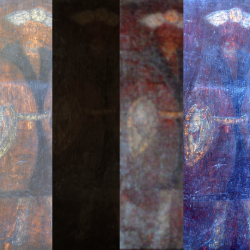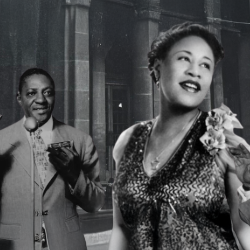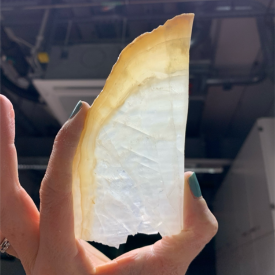An evolving room of the
future created by designers from Northumbria University’s Interaction Research
Studio has
been transformed with a winter scenario to help visitors imagine what New
Year’s Eve celebrations might look like in 25 years’ time.
The Converted Flat in 2049 is one of seven period
rooms built to reflect stories in time – past, present and future – as part of
the Real Rooms project which opened
in July at the Museum of the Home in London.
 Supported by Innovo and set in Hackney, where the Museum is based, the flat
features futuristic devices and furniture developed and created by designers
and technologists from the Interaction Research Studio (IRS) team, who carry out their research at the University’s London Campus.
Supported by Innovo and set in Hackney, where the Museum is based, the flat
features futuristic devices and furniture developed and created by designers
and technologists from the Interaction Research Studio (IRS) team, who carry out their research at the University’s London Campus.
From Mycelium insulation made from fungus to multigenerational
living, the team have imagined how evolving tastes, societal changes and the
climate crisis might dictate our future homes, and have even developed
scenarios for fictional characters who might inhabit the space.
The view from the flat’s window has also been imagined
by the team and created for the exhibition. It reveals a transformed London in
2049, adapting to climate change and technological innovation. Visitors can
expect to see a view which shows energy kites harvesting electricity from the
winds above the city, while emissions patrol drones scan rooftops for illegal
smoke. Green-clad buildings with living walls dominate the skyline, and
protective 'jackets' shield historic structures from relentless storms and
heatwaves.
 Associate Professor Andy Boucher, from the
Interaction Research Studio, said: “Being asked to produce a room of the future
has been an extraordinary experience for our team. We’re used to designing for
real-world situations in the present, so imagining what life might be like in
25 years required a real shift in approach. We knew from previous visions of
the future that they are almost always wrong, but one thing we could
confidently predict was the impact of climate change – so that became our
starting point. From there, we developed a set of fictional characters to
inhabit this multi-generational home and built stories around their lives,
exploring what it might mean to live in a London adapting to climate change.
Associate Professor Andy Boucher, from the
Interaction Research Studio, said: “Being asked to produce a room of the future
has been an extraordinary experience for our team. We’re used to designing for
real-world situations in the present, so imagining what life might be like in
25 years required a real shift in approach. We knew from previous visions of
the future that they are almost always wrong, but one thing we could
confidently predict was the impact of climate change – so that became our
starting point. From there, we developed a set of fictional characters to
inhabit this multi-generational home and built stories around their lives,
exploring what it might mean to live in a London adapting to climate change.
“We’ve spent so much time with these characters
– imagining their hopes, dreams, and struggles – that they’ve started to feel real
to us. For example, Ali, the youngest of the household, represents a new
generation determined to fix the planet through lifestyle choices, like
refusing to eat farmed food. And then there’s Jo, an 81-year-old ex-raver, who
relives memories of their youth using a VR-like device that induces a
trance-like state – while also occasionally arguing with Ali about her right to
enjoy a good steak whenever she pleases. These personal dynamics bring the
speculative designs and technologies to life, making them relatable and
tangible.”
Dean Brown, Senior Research Fellow from the
Interaction Research Studio, said: “One of the challenges we faced when
designing the room was how to depict plausible vision of a future that we
knew to be inherently unpredictable and transitory. As a design team we felt
these qualities and contradictions could be reflected in the look and feel of
the room itself.
“The approach we settled upon was to present a
room that had a clear sense of foreground and background – where
significant feature elements are vividly foregrounded against a background of
more simplified monotone grey set-works, walls and furniture
items. This is intended to suggest that details will be filled in as the future
evolves, conveying a sense of unfinished business with the future that is also
explicitly readable to a museum visitor.”
 Some of the concepts created by the Northumbria
team that visitors can expect to see as part of the Innovo Room of the Future are:
Some of the concepts created by the Northumbria
team that visitors can expect to see as part of the Innovo Room of the Future are:
Farm-Free Protein Machine
This kitchen appliance functions as a
mini-laboratory, producing protein mince from a proprietary blend of algae and
fungi. Compact and efficient, it allows users to fill the hopper with
lab-produced pellets, then customise the flavour and consistency. Designed to
make sustainable food production accessible, it supports farm-free diets while
being affordable and easy to use.
Better Life Digital Picture Frame
By 2049, this AI-enhanced digital photo frame
is considered a retro device. A dial on the front lets users adjust any
uploaded photo to appear “better” or “even better”. The AI decides what to
enhance – an image from a tube journey might transform into a private jet
flight, or a casual street selfie could become a glamorous red-carpet moment.
While the images aren’t real, they spark creativity, playful conversations, and
the joy of imagining what could have been.
HighPoint Memory Intensification System
HighPoint is a Virtual Reality-like device that uses pulsing
lights to manipulate neural rhythms, vibrating paddles to induce a dream-like
state, and AI-enhanced video to create an endless audiovisual journey. Designed
to help users relive cherished memories in vivid detail, it offers immersive
and dream-like experiences.
Modular Storage Sofa
 In the highly competitive housing market of
2049 London, renters frequently move to find affordable accommodation. The
storage sofa is designed for this transient lifestyle, easily disassembling
into lightweight parts for hassle-free transport. Its hidden compartments
provide a perfect solution for storing belongings that rarely get unpacked but
can’t be left behind.
In the highly competitive housing market of
2049 London, renters frequently move to find affordable accommodation. The
storage sofa is designed for this transient lifestyle, easily disassembling
into lightweight parts for hassle-free transport. Its hidden compartments
provide a perfect solution for storing belongings that rarely get unpacked but
can’t be left behind.
Among the festive updates the Innovo Room of
the Future has been given for the holiday period is the idea that the household
of fictional characters will celebrate “Renew Year’s Eve” – part of a holiday
called the Renewal Festival which the fictional story imagines has been
introduced as an inclusive way to treasure the year’s rebirth.
Speaking about the collaboration, Andy added: “Working
with the Museum of the Home has been incredible. It’s rare to find a partner so
open to experimentation and to creating spaces that challenge how we think
about the way we live and where we’re heading. The Museum’s commitment to
exploring the speculative future alongside the past and present has given us
the freedom to imagine bold and provocative ideas about the home in 2049. What’s
even more exciting is that we’ll be able to continue evolving the space over
the next decade, introducing new research and storytelling to keep the design
fresh, engaging, and thought-provoking.”
Led by Professor Bill Gaver and Associate
Professor Andy Boucher, the Interaction Research Studio (IRS) was established
almost 20 years ago and explores the design of computational systems for
everyday life, creating prototype products that encourage playfulness,
exploration and insight.
 Researchers use their interdisciplinary
knowledge to engage with settings and design highly-finished computational
products. Their intent is to suggest possibilities for technology that are not
explored commercially, and they ground their designs by encouraging participants
to live with the new designs and report back on how their experiences evolve.
The team put the user at the heart of determining how best to use a new product
or technology.
Researchers use their interdisciplinary
knowledge to engage with settings and design highly-finished computational
products. Their intent is to suggest possibilities for technology that are not
explored commercially, and they ground their designs by encouraging participants
to live with the new designs and report back on how their experiences evolve.
The team put the user at the heart of determining how best to use a new product
or technology.
Well-established in Human Computer Interaction
and Design communities, the IRS has won over £7m in funding since 2005,
publishes regularly in the distinguished Association for Computing Machinery (ACM) journals and has frequently exhibited at international venues including
the V&A, Tate Britain and New York Museum of Modern Art.
As well as the Innovo Room of the Future, the
Rooms Through Time exhibition documents four centuries of the evolution of home
life, beginning in 1630. All rooms have been curated through a mix of archival
research and oral history interviews, to explore and celebrate what home has
meant to different people over the decades, as well as what it may mean in the
decades to come.
Museum of the Home Director, Sonia Solicari,
said: “The history of the future is a rich research topic. It's fascinating to
look back at how previous generations imagined the future. In fact the
Victorians actually predicted the future and foresaw the invention of video
calls! The Interaction Research Studio’s 2024 version of 2049 living will
always be an interesting slice of history and this might end up as one of the
fastest-changing rooms in the museum. We’re excited to see it evolve over
time.”
The Real Rooms project is made possible by the
National Lottery Heritage Fund; by the industry leading construction and development
firm Innovo; and the Department for Culture, Media and Sport/Wolfson Museums
and Galleries Improvement Fund.
Until Sunday 12 January, all Rooms Through Time
have been redressed for the Museum of the Home’s annual Winter Festival exhibition, revealing new stories of festive celebrations
and traditions from the past 400 years – as well as what traditions might look
like in the future.
Discover more here about the
Interaction Research Studio and the Room of the Future project, and follow the
team on Instagram @irs_northumbria.

 Supported by
Supported by  Associate Professor
Associate Professor  Some of the concepts created by the Northumbria
team that visitors can expect to see as part of the
Some of the concepts created by the Northumbria
team that visitors can expect to see as part of the  In the highly competitive housing market of
2049 London, renters frequently move to find affordable accommodation. The
storage sofa is designed for this transient lifestyle, easily disassembling
into lightweight parts for hassle-free transport. Its hidden compartments
provide a perfect solution for storing belongings that rarely get unpacked but
can’t be left behind.
In the highly competitive housing market of
2049 London, renters frequently move to find affordable accommodation. The
storage sofa is designed for this transient lifestyle, easily disassembling
into lightweight parts for hassle-free transport. Its hidden compartments
provide a perfect solution for storing belongings that rarely get unpacked but
can’t be left behind.  Researchers use their interdisciplinary
knowledge to engage with settings and design highly-finished computational
products. Their intent is to suggest possibilities for technology that are not
explored commercially, and they ground their designs by encouraging participants
to live with the new designs and report back on how their experiences evolve.
The team put the user at the heart of determining how best to use a new product
or technology.
Researchers use their interdisciplinary
knowledge to engage with settings and design highly-finished computational
products. Their intent is to suggest possibilities for technology that are not
explored commercially, and they ground their designs by encouraging participants
to live with the new designs and report back on how their experiences evolve.
The team put the user at the heart of determining how best to use a new product
or technology.














